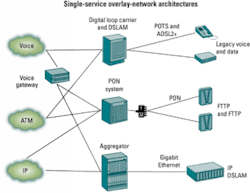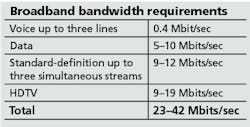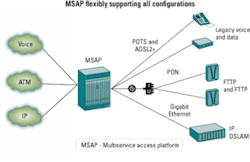Flexibility is key to successful fiber to the premises deployments
The decisions that telecommunications carriers make about their access networks will help determine the success or failure of their efforts to compete. Fiber suddenly may appear to be everywhere, but it is also different everywhere. Verizon is building an FTTP architecture. SBC has announced plans for fiber to the node (FTTN) and FTTP for greenfield. BellSouth has awarded contracts for both fiber to the curb (FTTC) and FTTN. Major independent operating companies like TDS are building both FTTP and advanced DSL (ADSL2+) networks. Even multiple systems operators (MSOs) like Grande Communications have started building FTTP networks.
So while it appears many carriers agree that fiber is necessary to carry the bandwidth needed to compete for triple play, it also seems that no one agrees on the correct fiber architecture.
Before investigating where the differences in fiber architectures arise and what it takes to cost-effectively deploy them, let’s define what they are:
• FTTP drives fiber all the way to the customer with zero drop length.
• FTTC drives fiber to an intermediate point within 1,000 ft of the customer.
• FTTN locates the fiber termination within 4,000-5,000 ft of the customer.
• Advanced DSL often upgrades existing DSL access multiplexers (DSLAMs) or digital loop carriers (DLCs) that can be up to 8,000 feet from the customer.
FTTP and FTTC are usually BPON fed. FTTN is fed with Gigabit Ethernet (GbE) optics. All these architectures must deal with the laws of physics that dictate the tradeoff between bandwidth and copper drop distance. New DSL technologies such as ADSL2+, VDSL, and VDSL2 offer high speeds over shorter lengths of copper, but all of them converge back to ADSL bandwidth (1.5 Mbits/sec) on loops of 8,000 ft or greater. Where the drop distances do not offer enough bandwidth to support anticipated services, some carriers are planning to bond multiple copper pairs to deliver the required speed.
Differences in fiber architecture are driven by the realities of the existing access networks and variations in the service rollout strategies for the carriers. One variable is the cost of upgrading to fiber over various types of local networks. Aerial plants cost less to upgrade to fiber than buried plant, for example, and that’s especially true for aerial drops from the pole to the home. Existing FTTC systems can more easily be upgraded to higher-bandwidth electronics than can copper networks. Dense neighborhoods around urban central offices (COs) often have short copper loops and can be upgraded with ADSL2+. Finally, FTTN is used where there is an intermediate point within 4,000-5,000 ft of the home. This intermediate point is often a service area interface (SAI) where there is a right of way but usually no power. The only agreement among differing carrier strategies is that FTTP is the right architecture for greenfield networks that must be newly built or substantially rebuilt.
Housing density and businesses introduce further variation. High-rises, garden apartments, duplexes, and condominiums are all examples of multidwelling-unit (MDU) homes. These homes require special fiber terminals that have extremely short drops but can serve multiple residences. Small and medium-sized businesses with requirements for DS-1 and transparent LAN Ethernet services also require unique architecture and equipment.
The differences caused by the existing network are not likely to cause controversy. The real discussion and hard decisions are related to service plans. The hybrid fiber/coax (HFC) access network used by cable MSOs is powerful, delivering 750 MHz to 1 GHz of analog bandwidth. Over that network, MSOs are delivering hundreds of standard-definition (SD) channels, cable-modem data service at up to 3 Mbits/sec, dozens of HDTV channels, and (increasingly) VoIP. Competing with these services is a formidable challenge for telecom carriers. A baseline of bandwidth requirements for a competitive offering is shown in the Table.
The major variable today is HDTV, which is currently compressed to 19 Mbits/sec per channel. Technologies such as MPEG4 and WM9 promise to improve that data rate to 9 Mbits/sec within 18 months. But content providers are very careful about the quality of their viewers’ experiences, and it may be some time after the new compression technology is available and proven before providers allow their content to be delivered at the higher compression rates at lower speeds. Moreover, as HDTV-capable televisions and personal video recorders penetrate the home market, viewers will demand multiple HDTV streams, so HDTV bandwidth requirements are likely to increase even as compression improves.
With all these considerations, there is still agreement that the access network must scale to at least 50 Mbits/sec, and in some cases up to 100 Mbits/sec. The controversy is where to start the upgrade. Carriers with FTTP plans focus on the ongoing improvement in the MSO HFC network and plan to build the ultimate bandwidth pipe to compete. Carriers with FTTN plans focus on the need to establish as wide a service footprint as possible as quickly as possible. Since FTTN with a 4,000-ft drop is limited to about 17 Mbits/sec of service, these carriers rely on the ability to quickly offer new services across their whole network. Along with compression improvements, carriers also look to VDSL2, copper bonding, and other technological improvements to increase the bandwidth to the minimum 24-Mbit/sec offering.
As carriers start building their fiber networks to offer triple play services, bandwidth requirements can start under 20 Mbits/sec but must scale all the way to 100 Mbits/sec. That is the reality. There are two ways to deal with this reality: overlay-network architectures and multiservice-network architectures.Overlay networks are the traditional way to implement new services and technologies. As new services or network requirements arise, carriers and vendors develop new classes of network elements (NEs) to address the challenge. Examples of this approach are HDSL, DSLAMs, DLCs, and increasingly packet voice gateways. These single-function NEs are often developed in a close partnership between incumbent vendors and their customers. They are usually deployed in large COs where there is enough service demand to route the various services to the various single-service NEs and get some economies of scale. Such overlays are viewed as a safe way to deliver new services. Figure 1 shows an example of an overlay system.
The drawbacks of the single-purpose overlay approach are evident in the telecom network today, because they have necessitated multiple networks requiring multiple operating systems and craft teams to service them. While telecom carriers have succeeded in reducing their operating expenses, they have not been able to fundamentally eliminate costs because they are maintaining multiple architectures (TDM, ATM, and now IP networks as well as different access networks). The result is anything but simplicity.
Yet, carriers continue to make the tradeoff between the simplicity of introducing a single overlay NE and the complexity of maintaining multiple overlay networks. The primary example in today’s fiber build-out is the IP DSLAM being used to build FTTN networks.
FTTN is clearly an attractive architecture as part of an overall competitive fiber strategy, and the IP DSLAM that provides the node function is well suited to the task. The DSLAM terminates a GbE uplink and serves ADSL2+, VDSL, or VDSL2 toward the customer. An IP DSLAM in an FTTN configuration is not in itself an overlay. The overlay occurs in the CO aggregation device that serves multiple IP DSLAMs and aggregates their GbE uplinks into the IP/MPLS core. These aggregation devices may be single-function IP-only devices or may be multifunctional.
The IP-only approach to FTTN aggregation assumes that the network is migrating quickly to an all-IP architecture. It ignores the existence of other protocols in the network, such as TDM and ATM, except as encapsulated in IP. It also relegates the aggregation of other fiber architectures-FTTC and FTTN-to other single-purpose PON systems. Essentially, the IP-only approach to FTTN aggregation creates a single-purpose IP overlay in the access network.
The alternative to IP-only aggregation is the multiservice access platform (MSAP). These platforms are purpose-built to bridge the protocols from TDM to ATM to IP. They are also built to serve different fiber configurations, including BPON for FTTP and FTTC, GbE for FTTP, and legacy functions for voice and ADSL2+ service.In the multiservice approach to FTTN, the IP DSLAM is seen as one of several ways of terminating the fiber bandwidth in the access network and delivering the high-bandwidth service to the customer. The FTTN architecture is not built as an overlay but as part of a common architecture that focuses on the services rather than the protocol. The common point for the various fiber architectures is the MSAP. The result is a flexible approach that can recognize the variability of network and service plans within the carrier’s overall architecture. The MSAP incorporates five major functions:
• Legacy access-DLC and DSLAM.
• PON with BPON today and a path to evolve to GPON.
• Voice gateway both for GR-303/TR-08 and packet voice, including H.248 and SIP.
• Integrated transport of SONET and GbE.
• International group multicast protocol (IGMP) functions to deliver IPTV.With these five functions, the MSAP delivers both service versatility and network flexibility. MSAPs deliver lifeline voice and packet voice services. They provide high-speed data from ADSL2+ and VDSL/VDSL2 where the loops are short. For PON applications, MSAPs deliver BPON and offer an evolution path to GPON or GEPON. For FTTN, MSAPs provide GbE links to IP DSLAMs. Figure 2 shows a common multiservice network delivered by the MSAP.
The MSAP also recognizes the essential architectural division of function between switching and access in the telecom network. The MSAP is a Layer 1 and Layer 2 system-it terminates physical connections to the customer and aggregates them onto links or switches that define the service. Access systems also perform some limited switching functions, thereby lowering the cost of switching. For example, GR-303 support in the MSAP saves Class 5 switch ports by providing concentration in the access system. The MSAP also performs limited Layer 3 functions, particularly IGMP for multicast IP, because IGMP is more cost-effectively performed in the access system than in the Layer 3 device. And because it doesn’t support Layer 3 functions, the MSAP can be provisioned and maintained without training the telecom craftsmen to be router specialists.
In addition, the MSAP increases the cost-effectiveness of the network in several ways. Of course, it must be able to deliver access functions at cost points that are competitive with single-purpose systems like DLCs or SONET add/drop multiplexers (ADMs). But it also drives cost out of the network by fundamentally simplifying the network. The simplification can be as easy as eliminating inter-shelf cabling-integrating the transport function reduces the cabling between the access system and SONET ADM. Connecting these functions in software across a backplane is much more efficient and easier to maintain than cabling two boxes together.
At a higher level, the MSAP simplifies the network by ending the need for multiple overlay systems to deliver the end-customer service. The MSAP architecture recognizes that end customers are buying a service not a protocol or configuration. It does not matter to end customers whether they get access to IPTV or high-speed data over aerial or buried wires; over a TDM, ATM, or an IP network; or via FTTP, FTTC, or FTTN. What they care about is the service, when it is available, how reliable it is, and how it can grow and scale as service evolves and technology improves. The MSAP aggregates all the variability in the access network and its interfaces to the core network and delivers everything from a common platform.
Telecom carriers are investing in their access networks to delivery triple play services and compete with MSO HFC networks. They are pursuing FTTP, FTTC, and FTTN architectures for reasons dictated both by their existing networks and their service plans. There are differences in implementation of both fiber and packet networks-between and within carriers. Carriers are also moving from their existing TDM and ATM networks toward IP service networks.
In making their investment, carriers can pursue past strategies of building single-purpose overlay networks, or they can simplify their networks with MSAP. Today, both strategies are being pursued. As the competition plays out among telecom carriers and MSOs over the coming months and years, telecom carriers’ success or failure will rest heavily on the decisions they make about the architecture of their access systems.Don McCullough is director of marketing at Entrisphere (Santa Clara, CA, www.entrisphere.com).



